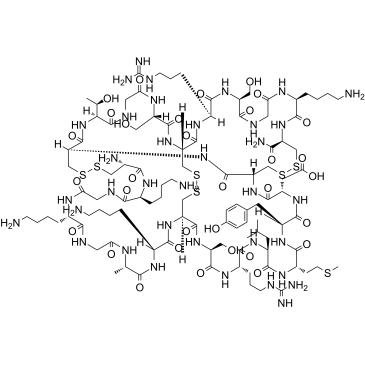ω-Conotoxin MVIIA

ω-Conotoxin MVIIA structure
|
Common Name | ω-Conotoxin MVIIA | ||
|---|---|---|---|---|
| CAS Number | 107452-89-1 | Molecular Weight | 2639.134 | |
| Density | 1.6±0.1 g/cm3 | Boiling Point | N/A | |
| Molecular Formula | C102H172N36O32S7 | Melting Point | N/A | |
| MSDS | Chinese USA | Flash Point | N/A | |
| Symbol |

GHS06 |
Signal Word | Danger | |
|
The effect of spider toxin PhTx3-4, ω-conotoxins MVIIA and MVIIC on glutamate uptake and on capsaicin-induced glutamate release and [Ca2+]i in spinal cord synaptosomes.
Cell. Mol. Neurobiol. 31(2) , 277-83, (2011) In spinal cord synaptosomes, the spider toxin PhTx3-4 inhibited capsaicin-stimulated release of glutamate in both calcium-dependent and -independent manners. In contrast, the conus toxins, ω-conotoxin MVIIA and xconotoxin MVIIC, only inhibited calcium-depende... |
|
|
Rationale for Prospective Assays of Intrathecal Mixtures Including Morphine, Ropivacaine and Ziconotide: Prevention of Adverse Events and Feasibility in Clinical Practice.
Pain Physician 18 , 349-57, (2015) Use of intrathecal admixtures is widespread, but compounding these is sometimes challenging and may result in errors and complications causing super-potency or sub potency adverse events in patients or malfunctions in the pump itself.The purpose of this study... |
|
|
Prolonged delirium with psychotic features from omega conotoxin toxicity.
Pain Med. 14(3) , 447-8, (2013)
|
|
|
[Neuropsychiatric side effects of intrathecal ziconotide].
Rev. Neurol. 52(1) , 61-3, (2011)
|
|
|
Ziconotide combination intrathecal therapy: rationale and evidence.
Clin. J. Pain 26(7) , 635-44, (2010) Ziconotide is a nonopioid intrathecal analgesic used to manage moderate to severe chronic pain. Although ziconotide is approved in the United States for intrathecal monotherapy only, it is often used in combination with other intrathecal drugs in clinical pra... |
|
|
Pharmacotherapeutic potential of omega-conotoxin MVIIA (SNX-111), an N-type neuronal calcium channel blocker found in the venom of Conus magus.
Toxicon 36(11) , 1651-8, (1998)
|
|
|
A novel series of pyrazolylpiperidine N-type calcium channel blockers
Bioorg. Med. Chem. Lett. 22(12) , 4080-3, (2012) Selective blockers of the N-type calcium channel have proven to be effective in animal models of chronic pain. However, even though intrathecally delivered synthetic ω-conotoxin MVIIA from Conus magnus (ziconotide [Prialt®]) has been approved for the treatmen... |
|
|
Analgesic effect of highly reversible ω-conotoxin FVIA on N type Ca2+ channels.
Mol. Pain 6 , 97, (2010) N-type Ca2+ channels (Ca(v)2.2) play an important role in the transmission of pain signals to the central nervous system. ω-Conotoxin (CTx)-MVIIA, also called ziconotide (Prialt®), effectively alleviates pain, without causing addiction, by blocking the pores ... |
|
|
Pharmacokinetic analysis of ziconotide (SNX-111), an intrathecal N-type calcium channel blocking analgesic, delivered by bolus and infusion in the dog.
Neuromodulation 15(6) , 508-19; discussion 519, (2012) Ziconotide is a peptide that blocks N-type calcium channels and is antihyperalgesic after intrathecal (IT) delivery. We here characterize the spinal kinetics of IT bolus and infused ziconotide in dog. Male beagle dogs (N= 5) were prepared with chronic IT l... |
|
|
Spider peptide Phα1β induces analgesic effect in a model of cancer pain.
Cancer Sci. 104(9) , 1226-30, (2013) The marine snail peptide ziconotide (ω-conotoxin MVIIA) is used as an analgesic in cancer patients refractory to opioids, but may induce severe adverse effects. Animal venoms represent a rich source of novel drugs, so we investigated the analgesic effects and... |